Išpuini, son of Sarduri I
Išpuini was the son of Sarduri I, son of Lutibri, and thus the son of the first Urartian ruler to be known from his own inscriptions as well as the possible founder of the dynasty that ruled for many generations to come. Išpuini reigned from approximately 830-820 BC and was a contemporary of the Assyrian king Šamši-Adad V (823-811 BC), who referred to him in an annalistic inscription as Ušpina. Šamši-Adad V claimed that he sent his chief eunuch on his second campaign to the Nairi lands, where he defeated 300 cities of Šarṣina, son of Meqdiara, and 11 fortified cities, along with 200 cities of Ušpina (Šamši-Adad V 01 [RIMA 3 A.0.103.1] ii 16b-34a [http://oracc.museum.upenn.edu/riao/Q004738])
Written sources
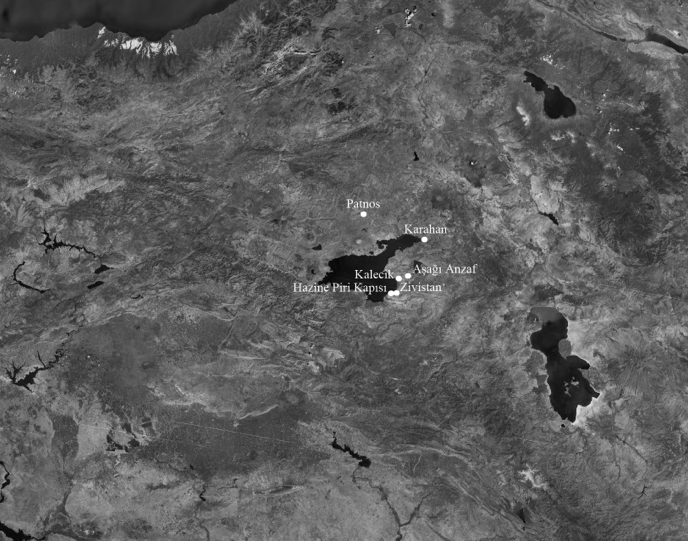
Map showing the distribution of Išpuini's inscriptions.
A great number of written sources from Išpuini's reign have come down to us. Most of them are stone inscriptions, but there are also some inscriptions on metal objects. The texts of both groups can be divided into three categories: The first consists of texts that tell us about deeds achieved by Išpuini alone (A 2 and B 2). The second comprises inscriptions concerning deeds that were achieved by Išpuini and his son Minua (A 3-1 and B 3, see portal page Išpuini and Minua [http://oracc.iaas.upenn.edu/ecut/urartianrulersandchronology/ipuiniandminuaa03/index.html]), and the third consists of a single text that mentions Išpuini along with his son Minua and his grandson Inušpua (A 4 and B 4, see portal page Išpuini, Minua, and Inušpua [http://oracc.iaas.upenn.edu/ecut/urartianrulersandchronology/ishpuiniminuaandinushpuaa04/index.html]).
| Išpuini / Assyrian Ušpina Synchronism: approx. 820 BC = 2nd campaign of Šamšī-Adad V | |
|---|---|
| Assyrian Sources | |
| Šamši-Adad V 01 [RIMA 3 A.0.103.1] ii 16b-34a : 2nd campaign led by the chief eunuch Muṭarris-Aššur to the land Nairi, conquest of 11 fortified cities as well as 200 other cities of Ušpina (year 820) | |
| Urartian Sources | |
| Stone inscriptions | Inscriptions on metal objects |
| CTU A 02-01: two-line inscription on a cylindrical stone (probably a column base), both lines contain the same content reporting the construction of the burganani to which the stone belongs; provenience: fortress of Kalecik (5 km north of the Van fortress) | CTU B 02-02: three bronze fragments; Assyrian inscription; provenience: Yukarı Anzaf |
| CTU A 02-02, A 02-07 and A 02-08: inscriptions on cylindrical stone blocks (probably column bases), reporting the construction of the respective building (É); provenience: Elmalık (former Zivistan) (A 02-02) and Aşağı Anzaf (A 02-07 and A 02-08) | CTU B 02-02: three bronze fragments; Assyrian inscription; provenience: Yukarı Anzaf |
| CTU A 02-03 and A 02-04: stone fragments, due to their state of preservation the contents are unclear, A 02-03 mentions the god Quera; provenience: Elmalık (former Zivistan) | CTU *B 02-03: bronze helmet with Assyrian or Urartian inscription; provenience: unknown |
| CTU A 02-05: inscription in a rock niche reporting the planting of an orchard and a vineyard as well as the creation of the inscription; provenience: Hazine Piri Kapısı near Elmalık (former Zivistan) and Edremit | CTU *B 02-04: silver bucket with Assyrian inscription given to Inušpua, grandson of Išpuini |
| CTU A 02-06: inscription on three stone blocks belonging to the fortress of Aşaǧı Anzaf and reporting its construction (É.GAL); provenience: Aşaǧı Anzaf | CTU *B 02-05 and *B 02-06: two fragments of two bronze helmets with Assyrian inscriptions mentioning Išpuini |
| CTU A 02-09: two duplicate inscriptions on two stelae reporting the construction of "this Gate of the God Haldi" in the "City of the God Haldi"; and the erection of "this stele(?) (ṭiribišuzi) of the god Ua" in the "City of the God Haldi", and the building of a new fortress, a burganani, and a new vineyard and orchard; provenience: Karahan, which Išpuini refers to as the "City of the God Haldi" | CTU B 02-07 A-E: six bronze rings with Assyrian inscriptions |
| CTU 02-10: inscription on a cylindrical stone (presumably a column base) reporting the building of a structure whose name is not preserved; provenience: Anzavurtepe (Aznavurtepe/Patnos) | |
| Bibliography: Salvini (1995: 34-38); Fuchs (2012: 136, study and date of the 2nd campaign of Šamši-Adad V) | |
Written sources mentioning deeds accomplished by Išpuini alone
Royal Titles
In most inscriptions, Išpuini refers to himself using only his name and that of his father: "Išpuini, son of Sarduri." The only exception among the stone inscriptions is (CTU 1 A 2-6A [http://oracc.iaas.upenn.edu/ecut/corpus/Q006881]), where Išpuini refers to himself as "strong king, great king, king of the Bia lands." In an inscription composed in the Assyrian language and engraved on five duplicate bronze rings (CTU IV B 2-7), Išpuini calls himself "Išpuini, son of Sarduri, great king, strong king, king of the world, king of the Land Nairi."
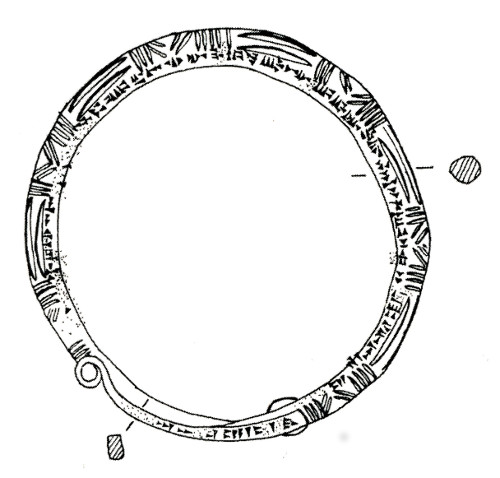
Bronze Ring of Išpuini with inscription in the Assyrian language from Yukarı Anzaf Fortress, in: Mirjo Salvini, CTU III: 21
Building Activities
The inscriptions authored by Išpuini alone mainly inform us about his building activities in the region around Lake Van. In total, 10 of these inscriptions have come down to us. Most are inscribed on stone objects which were once part of the buildings referred to in the inscriptions. We also have a duplicate inscription, which is inscribed on two stelae (A 2-9), and an inscription engraved in a rock niche (inscription of Hazine Piri Kapısı A 2-5).
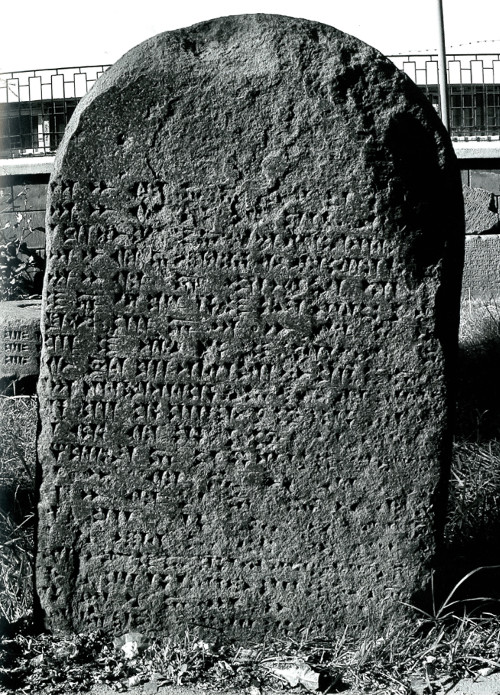
One of Išpuini's stelae from Karahan with the inscription A 2-9 A kept in the Museum of Van, in: Mirjo Salvini, CTU III: 63
With the exception of the rock niche inscription, none of the inscriptions were found in their original archaeological or architectural contexts. Information about the nature of the building to which the inscribed stone objects once belonged must therefore be primarily obtained from the contents of the inscriptions themselves. Unfortunately, the building terms used in the texts are often only generic (such as É "building") or unclear in their meaning. In some cases, further clues are provided by the type and shape of the inscribed stone object itself.
In several inscriptions, Išpuini reports the building of fortresses in the region around Lake Van. These inscriptions were discovered are Kalecik (7 km in the northwest of Van Kalesi, A 2-1), Aşağı Anzaf Kale (Lower Anzaf Fortress, approx. 10 km northeast of Van, A 2-6, A 2-7 and A 2-8), Elmalık (former Zivistan, 12 km south of Van, A 2-2, A 2-3, A 2-4), Anzavurtepe (or, respectively, Aznavurtepe or Patnos, 50 km northwest of Van, A 2-10), and Karahan (66 km northeast of Van, which Ipuini refers to as "the City of the God Haldi," A 2-9).
Išpuini further reports the construction of buildings which are referred to by the generic term É ("building, house"). Inscriptions of this kind stem from Elmalık (Zivistan, A 2-2) and Aşağı Anzaf (A 2-7 and A 2-8). The fact that they are inscribed on cylindrical stones suggests that the building consisted of columns. This, as well as the fact that the inscriptions refer to the protection of the god Haldi, through which the building was created, indicates that it was an important official and representative building within the fortresses.
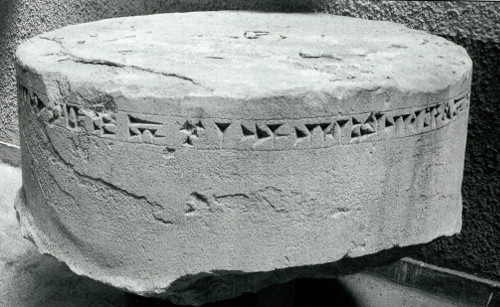
Cylindrical Stone from Aşağı Anzaf with inscription A 2-8, kept in the Museum of Van, in: Mirjo Salvini, CTU III: 62
In inscription A 2-5, engraved on the rock niche at Hazine Piri Kapısı, located near the fortress Elmalık (former Zivistan) and Edremit, Išpuini reports that he planted a vineyard and a fruit orchard. He further states that he created the inscription for his "Lord." Although this kind of reference is not known from any other Urartian inscription, it likely refers to the god Haldi who in other inscriptions is called "the Lord" or "his Lord."
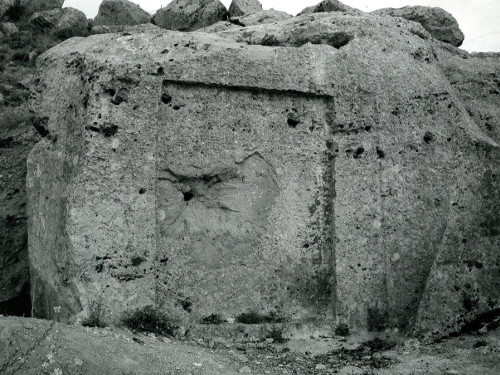
The rock niche at Hazine Piri Kapısı with the inscription A 2-5, in: Mirjo Salvini, CTU III: 58
The creation of a vineyard and an orchard is also mentioned in the duplicate inscription A 2-9, which is engraved on two stelae from Karahan (see the image above). Among the inscriptions authored by Išpuini alone, A 2-9 is the only one with religious content (A 2-2 may also be religious in nature, however this remains unclear due to its fragmentary state of preservation). Thus, A 2-9 reports the building of a "Gate of the God Haldi" and a ṭiribišuzi for the god Ua. Both constructions are referred to with the demonstrative pronoun "this" and are described as being situated in the "City of the God Haldi." The latter is apparently the name of an Urartian settlement situated near the modern village Karahan in the district of Muradiye. The term ṭiribišuzi is also attested in three inscriptions from Išpuini's son, Minua, namely A 5-28, A 5-3 and A 5-31, all of which stem from Karahan. Similarly to A 2-9, inscriptions A 5-28 and A 5-30 report the erection of a ṭiribišuzi for the god Ua/Ura or, respectively, the god Nala (A 5-31) along with the building of a "Gate for the God Haldi," a fortress, a vineyard, a fruit orchard, and a burganani. In contrast to A 2-9, Minua refers to the place where he built the various structures not as "the City of the God Haldi," but rather as "the City Arṣuniuini." Unlike his father, he claims to have built the city. Most likely, Minua expanded the city formerly known as "City of the God Haldi." We might assume that, during Išpuini's reign, the place was a kind of holy city or cult settlement which, during the reign of Minua, was considerably expanded and renamed Arṣuniuini.
The terms "Gate of the God Haldi" and ṭiribišuzi clearly refer to constructions which were part of the cult site. The term "Gate of the God Haldi" probably referred to a cultic gate building for the god Haldi. The erection of such gates is mentioned in several other inscriptions. Besides gates of the god Haldi, gates for the god Ua/Ura are also attested, as well as gates of the weather gods and sun gods of various cities.
From the fact that the term ṭiribišuzi is accompanied by the verb ku(y)- "set up, erect" it probably refers to a "stele." The more common term for stele is, however, (NA4) pulusi which is also accompanied by the verb ku(y)- or, in the case of A 5-31 rev. 2, with zad- . The term ṭiribišuzi might therefore differ slightly in its meaning from pulusi in that it refers more to the function of the object rather than its design. Thus, it might be translated as "cult stele." Alternatively, Salvini (1993: 543-548 and CTU V: 420) suggests that ṭiribišuzi might refer to the sanctuary of the stele. In this case, however, it would be more likely be accompanied by the verb šid- "build" or zad- "make").
The meaning of the term burganani is also unclear. Since it is accompanied both by the verb ter- "put, install, establish" and šid- "build," it presumably refers to a building. The fact that in several inscriptions it is used in connection with the Urartian terms for "vineyard," "orchard," and sacrificial animals suggests that it refers to an installation where those animals were kept. It might therefore be translated as "stable" or "pen."
Interestingly, only inscriptions authored by Išpuini, Išpuini and Minua, or Išpuini, Minua, and Inušpua mention building gates for a specific deity, burganani buildings, or the erection of ṭiribišuzi objects.
Metal objects
In addition to stone inscriptions, Išpuini also authored several inscriptions found on metal objects. Some of them mention him alone (B 2), whereas others refer to him and his son Minua (B 3) or, respectively, to him, his son Minua and Minua's son Inušpua (B 4) as donors of votive offerings (see portal page Išpuini and Minua [http://oracc.iaas.upenn.edu/ecut/urartianrulersandchronology/ipuiniandminuaa03/index.html], and Išpuini, Minua and Inušpua [http://oracc.museum.upenn.edu/ecut/urartianrulersandchronology/ishpuiniminuaandinushpuaa04/index.html]; for the texts see Salvini 2012, 19-27).
The inscriptions authored by Išpuini alone refer to him as the donor of votive offerings to the god Haldi and as the owner of helmets. One inscription on a silver bucket (B 2-4) is more personal in character; it states that Išpuini gave the bucket to his grandson Inušpua as a gift.
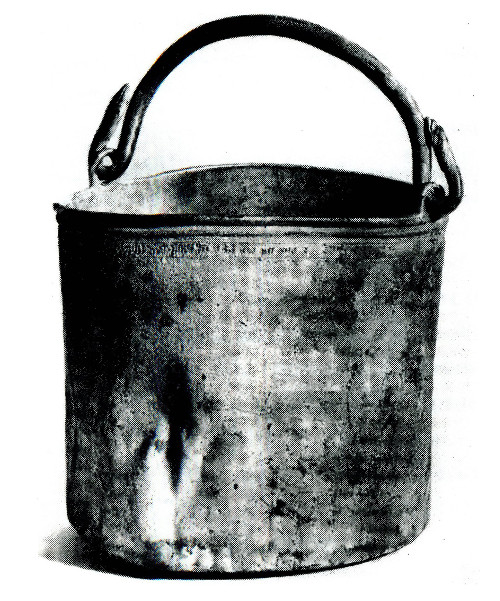
Silver bucket with inscription B 2-4 given by Išpuini to his grandson Inušpua, photo: CTU IV: 20
Language
Breaking with his predecessor Sarduri, whose inscriptions were written in Assyrian, Išpuini's was the first king to compose inscriptions in the Urartian language. However, a small number of inscriptions on metal objects were written in Assyrian (B 2-5 - B 2-7). Furthermore, the famous inscription (A 3-11 [http://oracc.iaas.upenn.edu/ecut/Q006896]), inscribed on a stele originally located in Kelišin, is an Urartian-Assyrian bilingual text. It was authored by Išpuini and his son Minua and records their military campaigns (see portal page Išpuini and Minua [http://oracc.iaas.upenn.edu/ecut/urartianrulersandchronology/ipuiniandminuaa03/index.html]).
Religious activities
The power to accomplish their respective deeds was attributed to the god Haldi in the majority of inscriptions authored by Išpuini alone (A 2) and by the inscriptions authored by Išpuini together with Minua and Inušpua (A 3 and A 4). Other texts refer to Haldi as the beneficiary of the inscription or inscribed object, or other items mentioned in the text.
This contrasts with the inscriptions of Išpuini's predecessor, Sarduri I, which do not mention Haldi at all. Along with other evidence, this probably indicates that Haldi became the Urartian national god only during Išpuini's reign. The introduction of the Haldi cult was probably mainly based on political factors, such as the intention to unite the various population groups by giving them a common religious identity.
Another god mentioned in the inscriptions attributed to Išpuini alone is the god Ua. Thus, Išpuini reports in A 02-09 [http://oracc.iaas.upenn.edu/ecut/Q006884] that he erected two cult stelae (ṭiribišuzi) in the City of the God Haldi for Ua, along with a Gate of the God Haldi, a fortress, a vineyard, a burganani, and a fruit orchard.
In addition, one inscription composed by Išpuini refers to the god Quera. Unfortunately, the text is only fragmentarily preserved (A 02-03 [http://oracc.iaas.upenn.edu/ecut/Q006878] fragment A). In the texts reporting the deeds of Išpuini and Minua, numerous other gods of the Urartian pantheon are mentioned, most of them as recipients of offerings in the great offering text A 03-01 [http://oracc.iaas.upenn.edu/ecut/Q006886] from Meher Kapısı (see portal page Išpuini and Minua).
Further reading
Birgit Christiansen
Birgit Christiansen, ' Išpuini, son of Sarduri I ', Electronic Corpus of Urartian Texts (eCUT) Project, The eCUT Project, a sub-project of MOCCI, 2020 [http://oracc.museum.upenn.edu/ecut/urartianrulersandtheirinscriptions/ipuinisonofsarduriia2andb2/]